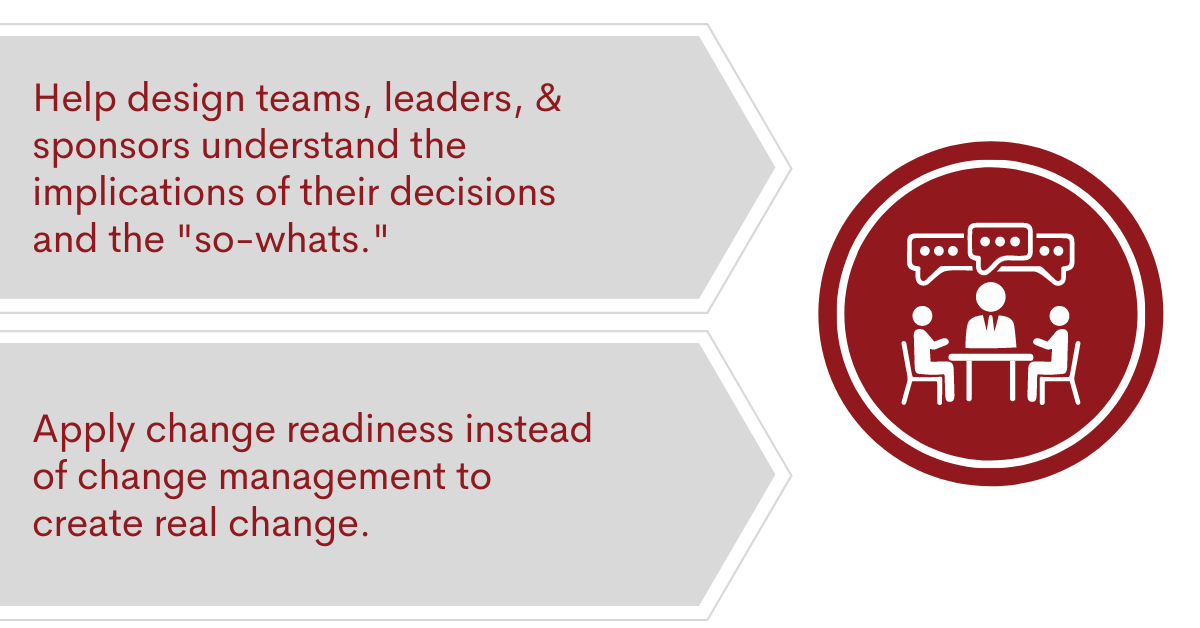6 minute read
Takeaway: Effective change agents must have the ability to freely move throughout the business as an Integrated Free Radical – fostering commitment, creating alignment, and identifying key social influencers. The change agent should be able to take a step back and understand the wider environment they’re working in. They can only do this if they have the freedom to move throughout all parts of the business or business unit.
Defining the role of the Change Agent as an Integrated Free Radical
An effective Change Agent, that is integrated to a wider change readiness strategy, operates as a free radical; facilitating meaningful conversations, agitating, and challenging sponsors and the design team(s), holding tension on decision making and helping to drive integrity and commitment to the change.
The role of an effective Change Agent is to be a catalyst, from sensing the need to change, planning and design, through to embedding. A Change Agent helps to guide and influence the process, but they don’t make the process about them. They must be clear about their role in any change process, and the role of the team members and group they are helping to support.
.png)
Fundamentally, the Change Agent helps to drive the process in terms of momentum, coherence [to the strategic intent] and alignment of the group.
The sponsor(s) and associated design team(s) are responsible for the content; which includes the choices, decisions, trade-offs and consequences. The Change Agent operates holistically, helping the design team and sponsors understand those choices and what the trade-offs are, but the Change Agent should never step in and make decisions for the group.
Traditionally, Change Agents (a catch-all term for super-users, process and data stewards, people reps etc.) are seen as the go-to person with significant degrees of influence on both process and content. What happens over time is their influence decreases and the role becomes passive and runs out of road. For example a Process Owner leaves the business and the role they held is not backfilled – this says a lot about how robust a business’ approach is to change readiness and sustained impact.
.png)
The Requirements of an Integrated Free Radical
Key skills OTM observe are an ability for the Change Agent to facilitate the change work at a holistic end-to-end business level, and help leaders, sponsors, and design teams to interpret the big “so whats” and implications. They help sponsors and design teams in the application of effective change readiness, which requires knowledge of how to apply the behavioural- and neuro- science of change in a highly pragmatic way.
They recognise the need to act as a key driver for coherence and integration, and as a result they invest time in understanding the wider environment they are operating in; using their direct experience of working in different sectors or expanding their networks within and across sectors to build a rich repository of context.
With the right enabling conditions, Change Agents freely roam the strategic context, using the insight gained to help sponsors and design teams to make decisions that are coherent with the strategic context.
Effective change agents also play a role in brokering commitment across boundaries in a business; working with the design team to identify the key social influencers and deal with change proactively.
Key Activities of an Integrated Free Radical
-1.png)

OTM’s Accelerated Change Readiness (ACR) approach differentiates itself from traditional “change management” in that it deals with change proactively, holistically, explicitly, and deliberately rather than being an afterthought. ACR differentiates itself from standard “project management” in that it forces project management to move away from treating an organisation like a car engine needing a tune up, to treating an organisation like a living, dynamic system where changes MUST be implemented to completion – all the way to end user adoption, to achieve ROI.
ACR is based on two fundamental assumptions, “people support what they help create” and “the organisation is a living, dynamic system” and must cultivate a high degree of personal relevance and meaning to the change – the anti-thesis of “telling.”
Practical Example From The Field
OTM partnered with a large healthcare provider to redesign the full enterprise; from the frontend health and care service delivery, through to the enabling services like Regulatory and Governance, HR, and IT.
The customer made it clear they wanted to have a joint role in facilitating the design process and engaged in significant upskilling, coaching, and mentoring through the process. As part of the Accelerated Change Readiness approach, they also established a team of internal Change Agents to interface across the various boundaries in the business.
Amongst many things, the Change Agents were particularly effective in;
- Knowing the context; helping the Executive Sponsors and design team see connections and contradictions in their strategic and operational aspirations.
- Identifying missing voices; with daily conversations across the business, as the process evolved, they spotted colleagues who had the knowledge and willingness to join the process and have their voice heard.
The momentum of the design process accelerated through both size of the group but also level of diverse perspectives involved. The dynamic was a beautiful art of sharing perspectives from “life on the frontline” to make the “strategic intent” practical and real.
This was ACR in real-world application as the Change Agents, through their process interventions, added significant alignment, meaning, hope and possibility, with a genuine ability of all participants to influence the design choices and decisions.
Read Part 3 of 3 of this blog series to learn more: The Enabling Conditions of a Change Agent.
Chris Furnell is a Consultant at ON THE MARK.
OTM is the leading global boutique organization design consultancy with offices in the USA and UK. With over 450 successful redesigns and operating model modernizations completed, OTM is the owner of the industry’s most integrated, comprehensive, and holistic organization design solution. OTM enables its clients to realize their future ambitions.



